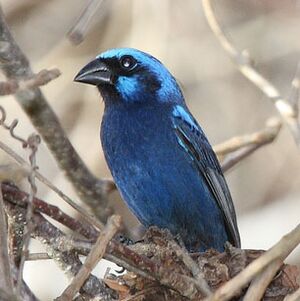Blue bunting facts for kids
Quick facts for kids Blue bunting |
|
|---|---|
 |
|
| Conservation status | |
| Scientific classification | |
 |
The blue bunting (Cyanocompsa parellina) is a small, colorful bird. It belongs to the Cardinalidae family, which includes cardinals and grosbeaks. You can find this bird in several countries. These include Belize, El Salvador, Guatemala, Honduras, Mexico, and Nicaragua.
Contents
About the Blue Bunting
How Scientists Name Birds
Scientists give every animal a special name. This helps everyone know exactly which animal they are talking about. The blue bunting got its first scientific names from a French scientist named Charles Lucien Bonaparte in 1850. Later, a German scientist, Jean Cabanis, gave it the name it uses today: Cyanocompsa parellina.
The blue bunting is the only bird in its group, called a genus. This genus is named Cyanocompsa. There are also four types of blue buntings, called subspecies. They are a bit different depending on where they live. These types are Cyanocompsa parellina parellina, C. p. beneplacita, C. p. indigotica, and C. p. lucida.
What Does a Blue Bunting Look Like?
The blue bunting is a small bird. It is about 13 to 14 cm (5.1 to 5.5 in) long. That's about the length of your hand. Male birds weigh between 11 to 24 g (0.39 to 0.85 oz). Females are a bit lighter, weighing 9.8 to 21 g (0.35 to 0.74 oz).
Male blue buntings are very colorful. They have different shades of blue. Their forehead and cheeks are sky blue. Their upper body is a darker, blackish blue. The rump (the lower back) is ultramarine blue. Their underside, from chin to belly, is a deep blue.
Female blue buntings look different. They are mostly dull brownish. Their belly might have a reddish color. Young male birds are gray-blue. They have a brownish wash on their belly.
The different subspecies have slight color changes. For example, the C. p. beneplacita male is a duller blue. Its female is paler. The C. p. lucida male has more sky blue on its head. The C. p. indigotica male is a dull indigo blue.
Where Blue Buntings Live
The blue bunting lives in many places. The most common type, Cyanocompsa parellina parellina, lives in eastern Mexico. It also lives south and east through Belize, Guatemala, Honduras, and El Salvador. You can find it in northwestern Nicaragua too.
Other types live in specific areas of Mexico. C. p. beneplacita is mostly in northeastern Mexico. Sometimes, it flies into Texas and Louisiana in the United States. C. p. lucida lives in northeastern and eastern Mexico. C. p. indigotica is found in western Mexico. It ranges from Sinaloa south to Oaxaca and Chiapas.
Blue buntings like to live in thick, bushy areas. They enjoy dense plants, thickets, and the edges of tall forests. In Mexico, they can live up to 1,800 m (5,900 ft) high in the mountains. In Guatemala, they live up to 900 m (3,000 ft) high.
Blue Bunting Habits
What They Eat
Blue buntings look for food alone or in pairs. They search through low plants and bushes. Scientists don't know much about their exact diet yet.
How They Raise Their Young
There is not much information about how blue buntings breed. They build nests that look like cups. These nests are made of small roots and other soft plant materials. They place their nests in bushes. Female blue buntings usually lay two or three eggs.
What They Sound Like
The blue bunting has a sweet song. It sounds a bit sad and warbling. You can hear an example of its song online [1]. Its call is a short, metallic sound [2].
Blue Bunting Status
The IUCN (International Union for Conservation of Nature) checks on animals around the world. They have said the blue bunting is a species of "Least Concern." This means it is not currently in danger of disappearing. The bird is quite common. It can also live in places where humans have changed the habitat a little bit.


